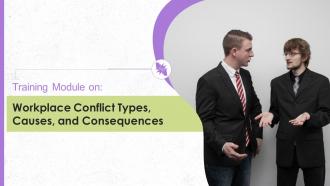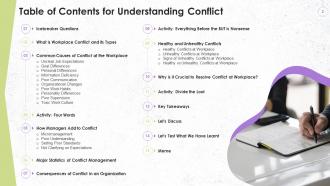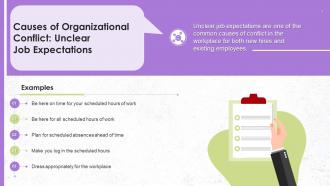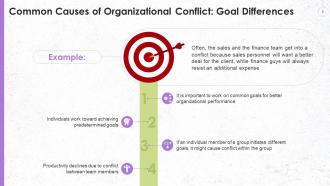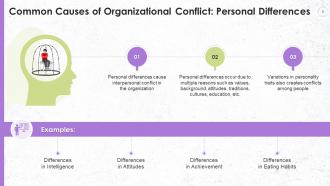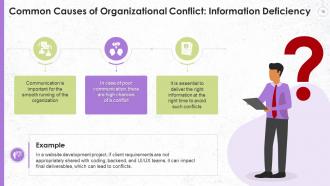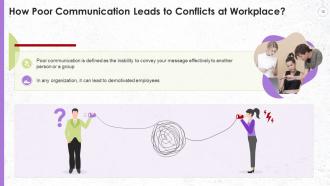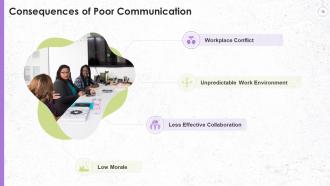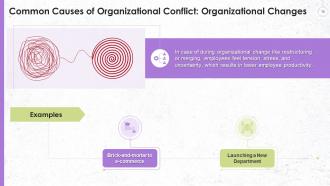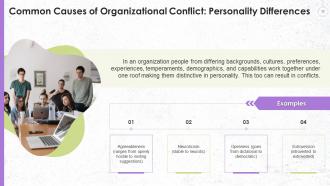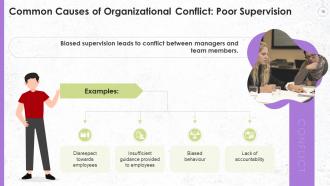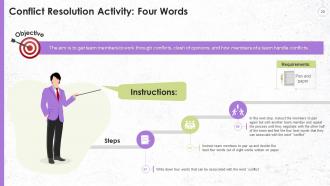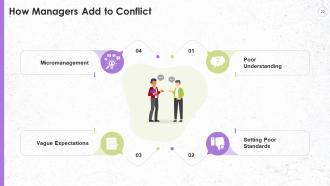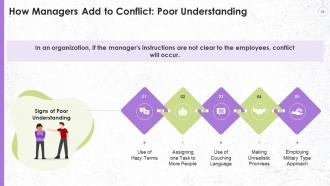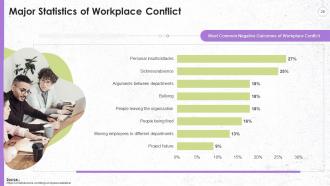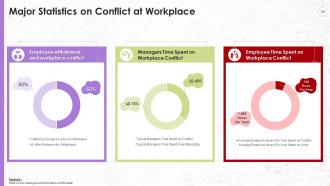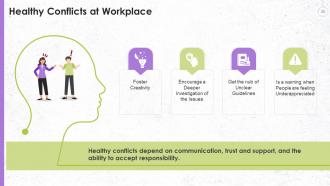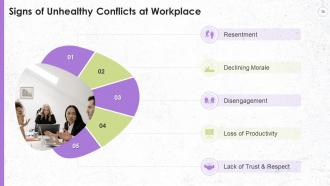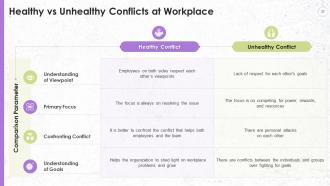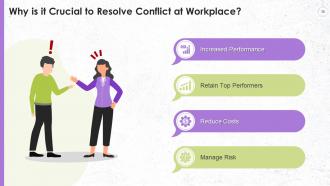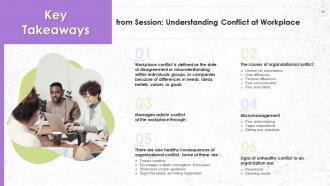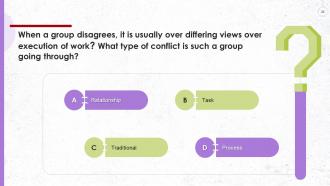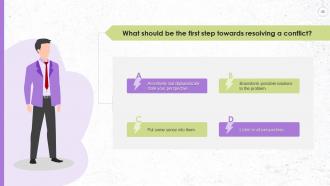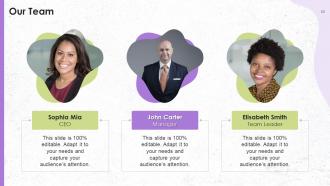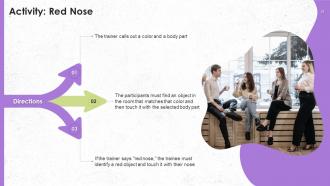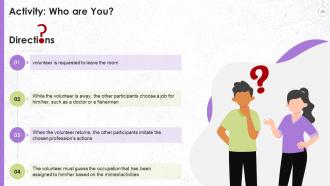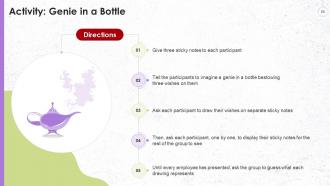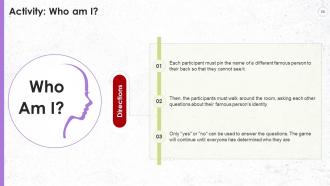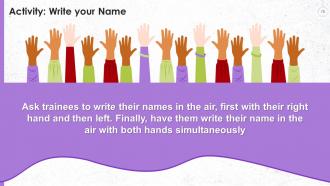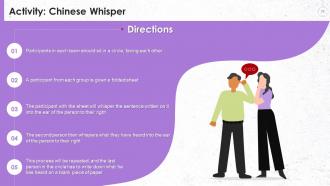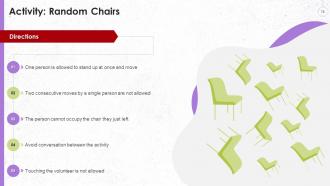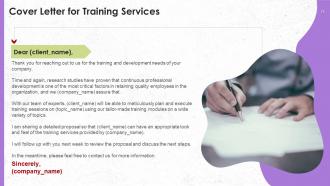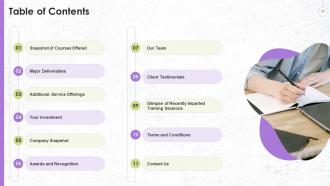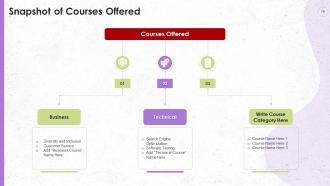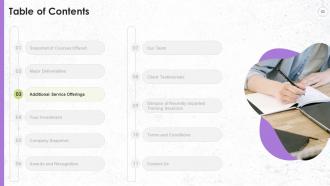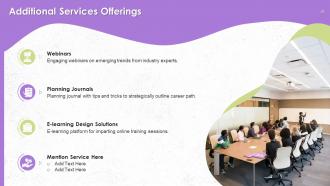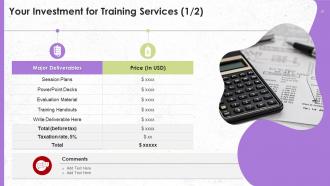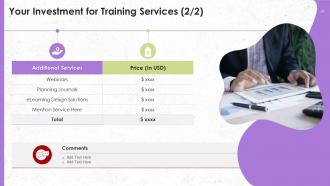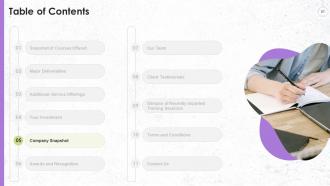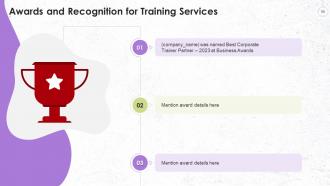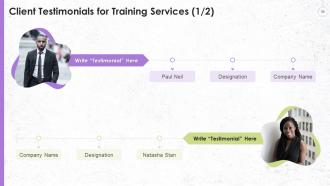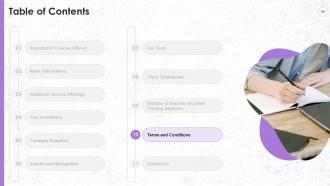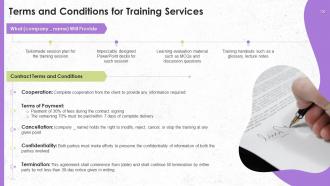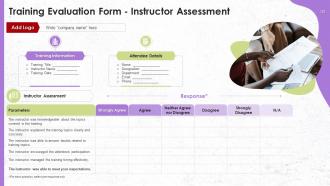Understanding Workplace Conflict Types Causes And Consequences Training Ppt
This training module on Conflict has icebreaker questions and organizational conflict types intrapersonal, interpersonal, intragroup, intergroup, and inter-organizational. In-depth, it also covers the common causes of workplace conflict, which are unclear job expectations, goal and personality differences, information deficiency, poor communication and supervision, organizational changes, and toxic work culture. It also contains how managers add to conflict with micromanagement, setting poor standards, and not clarifying expectations, along with the major statistics on conflict management. Further, it discusses the consequences of conflict in an organization and the signs of healthy and unhealthy conflicts. It has activities Four Words and Everything Before the BUT is Nonsense, key takeaways, and discussion questions related to the topic to make the coaching session more interactive. The deck has PPT slides on about us, vision, mission, goal, 30-60-90 days plan, timeline, roadmap, training completion certificate, and energizer activities. It also includes a client proposal and assessment form for training evaluation.
You must be logged in to download this presentation.
PowerPoint presentation slides
Presenting Training Deck on Workplace Conflict Types, Causes, and Consequences. This deck comprises of 105 slides. Each slide is well crafted and designed by our PowerPoint experts. This PPT presentation is thoroughly researched by the experts, and every slide consists of appropriate content. All slides are customizable. You can add or delete the content as per your need. Not just this, you can also make the required changes in the charts and graphs. Download this professionally designed business presentation, add your content and present it with confidence.
People who downloaded this PowerPoint presentation also viewed the following :
Content of this Powerpoint Presentation
Slide 4
This slide lists the questions a trainer can ask trainees before commencing a comprehensive training session on Conflict Management. We learn that all of us need to get better and more skillful in Conflict Management at the Workplace.
Slide 5
This slide provides information regarding the concept of organizational conflict. It also contains details of multiple types of organizational conflicts, such as intrapersonal, interpersonal, intragroup, intergroup, and inter-organizational.
Instructor's Notes:
Types of workplace conflict:
- Intrapersonal Conflict: When conflict occurs within the mind of an individual. It happens due to the individual's psychological traits not being in sync. The principal traits that can, sometimes, be in conflict and cause difficulties for an individual are Thoughts, Values, Principles and Emotions.
- Interpersonal Conflict: When conflict occurs between two individuals in an organization
- Intragroup Conflict: When conflict occurs between two individuals of the same team. This type of conflict arises due to incompatibilities and misunderstandings among team members
- Intergroup Conflict: When conflict occurs between teams within an organization. It happens due to varied and non-aligned sets of goals and interests of these groups
- Inter-organizational Conflict: When conflict occurs between companies when agreed-upon commitments are not honored, creating a cycle of discord even within the wider community.
Slide 6
This slide lists the major reasons that result in conflicts at the workplace. The causes are unclear job expectations, goal differences, personal differences, information deficiency, poor communication, organizational changes, poor work habits, personality differences, poor supervision, and toxic work culture.
Instructor's Notes:
Different causes of organizational conflict are:
Unclear Job Expectations:
- Unclear job expectations are one of the common causes of conflict at the workplace for both new recruits and existing employees
Goal Differences:
- It is important to work on common goals for better organizational performance
- If individuals have different or conflicting goals, it can lead to organizational conflict
- Productivity falls due to conflict between team members
Personal Differences:
- Differences between individuals' way of functioning can cause interpersonal conflict in the organization
- These differences arise due to contrasting values, background, attitudes, traditions, cultures, education, etc.
Information Deficiency:
- For smooth running of organizations, it is essential to share the correct information at the right time with others. This helps avoid conflicts to a major degree
Poor Communication:
- Lack of communication among team members leads to arguments, which if left unresolved, often escalate into
full-blown conflicts - To avoid such conflict, it is important to listen actively and share precise and clear information
Organizational Changes:
- In case of organizational changes like restructuring or merging, employees feel tension, stress, and uncertainty, which could result in lower productivity
Poor Work Habits:
- Certain individual’s habits such as non-completion of tasks on time also lead to conflict
Personality Differences:
- In an organization, people from different backgrounds, cultures, preferences, experiences, temperaments, demographics, and capabilities work together. Some of these differences can be a major source of conflict.
Poor supervision:
- Biased supervision also leads to conflict between managers and team members
Toxic work culture:
- Toxic work culture spreads negativity at the workplace, making employees unhappy leading to conflicts. It also results in abusive conduct, and bullying of individuals
Slide 7
This slide showcases unclear job expectations as one of the causes of organization conflict. It explains that unclear job expectations are often a major cause of concern for both new recruits and existing employees. Ultimately, people end up interpreting expectations in their own way, only to find that their manager expected something else from them. This leads to lowered morale and productivity.
Slide 8
This slide showcases goal differences as the cause of organization conflict. It explains that it is better to work on common goals to avoid Teams within the same organization cannot work at cross-purposes; the broad aim of each team has to converge at a point.
Slide 9
This slide depicts personal differences as the cause of organization conflict. It explains that personal differences can cause conflict in the organization.
Slide 10
This slide depicts information deficiency as the cause of organization conflict. It explains that communication is important for the smooth running of the organization.
Slide 11
The purpose of this slide is to highlight how miscommunication can lead to conflicts in the workplace. It also includes details of areas where the dispute arises, such as collaborative efforts, closed loops, and unchecked gossip.
Instructor's Notes:
The areas where conflict arises are:
- Collaborative Efforts: When working on a team project, if a manager doesn't clearly define and communicate roles and timelines, it can lead to missed deadlines and subsequent finger-pointing and blame games.
- Closed Loops: Lack of communication between departments leads to conflict. For example, employees from the sales department gave an extra discount on products to achieve their target, without communicating it to the finance department
- Unchecked Gossip: False information circulating through the office can create tension among employees, eventually leading to conflicts. Some common forms of unchecked gossip are:
- Concerns about job security
- Doubts about the company's plans/future
Slide 12
This slide showcases the importance of communication in minimizing conflict at the workplace. It explains that good communication helps avoid conflict and provides ideal conditions for improving productivity and growth.
Instructor’s Notes:
Good communication helps minimize conflict at the workplace as follows:
- Avoiding confusion
- Providing purpose
- Fostering a transparent company culture
- Creating accountability
- Enhancing productivity and growth
Slide 13
This slide lists multiple causes of poor communication at the workplace such as poor leadership, unclear objectives, limited feedback, demoralized employees, and inability to accept.
Instructor's Notes:
Different causes of poor communication at the workplace are:
Poor Leadership:
- In an organization, employees look for direction from their managers
- Good communication from top management helps motivate staff members to become more motivated and innovative
- Good leaders always communicate their objectives, goals, and future visions
- Poor communication starts when managers are unable to answer questions or clarify points
Unclear Objectives:
- In an organization, a clear understanding employees' objectives is necessary
- It requires focused, keyed-in employees who are aware about what their employee demands from them.
- If the manager fails to provide directions, this could lead to confusion and frustration among employees. This is a sure-shot way to create unnecessary conflict
Limited Feedback:
- Feedback is important in any organization for better performance from staff
- Poor communication, when giving feedback, hinders staff performance
Cultural Differences:
- In an organization, diversity of culture is important as it helps businesses get new ideas for greater creativity and innovation
- Diverse cultures can lead to poor communication, as people are reluctant to change or learn what the person actually means. For instance, some communication depends on symbols, which are easily misinterpreted
- Employees working in organizations comes from different cultures and backgrounds, and their way of communication differs
- Misunderstandings turn the conversation into a conflict
Slide 14
This slide lists the consequences of poor communication at the workplace such as unpredictable work environment, less effective collaboration, workplace conflict, and low morale.
Instructor's Notes:
Consequences of poor communication are:
Workplace Conflict:
- Poor communication can cause tension between employees, making conflict an inevitability
Unpredictable Work Environment:
- Unclear communication causes issues like the labelling of a company as an unstable organization. This has repercussions on sales and customer perception
- Employees lack clear understanding of the project, lowering productivity
Less Effective Collaboration:
- Collaboration and communication go hand-in-hand
- Collaboration helps in promoting self-analysis and effective problem-solving
Low Morale:
- It becomes difficult for employees to meet expectations due to poor when the communication is poor, This results in employees feeling embarrassed even developing a low self-esteem. It is ultimately, the business which pays the price in terms of lower productivity
Slide 15
This slide depicts organizational changes as the cause of conflict. It explains that during organizational change like restructuring or merging, employees feel tension, stress, and uncertainty, which results in lower employee productivity.
Slide 16
This slide depicts poor work habits as the cause of organization conflict. It explains that there are always individuals within any organization that fail to complete allocated tasks on time. This can have a cascading effect and affects performance of many departments, leading to unsavory conflicts.
Slide 17
This slide depicts personality differences as the cause of organization conflict. It explains that people with distinct personalities work under one roof which can result in conflict.
Slide 18
This slide depicts poor supervision as the cause of organization conflict. It explains that biased supervision leads to conflict between managers and team members.
Slide 19
This slide depicts toxic work culture as the cause of organization conflict. It explains that toxic work culture spreads negativity at the workplace making employees unhappy, leading to fights, leave alone conflicts.
Slide 20
This slide illustrates the four-word conflict resolution activity at workplace. It also explains necessary instructions to conduct the activity.
Instructor’s Notes:
Multiple questions asked after completing the activity are:
- How did they feel during the exercise?
- Did anyone feel uncomfortable during the exercise?
- Did anyone take control of the conversation?
- Was there any conflict?
- Would you do anything differently?
- What techniques did you use to come up with the four words?
- What did you learn during this exercise?
Slide 22
This slide lists ways by which managers, wittingly or unwittingly, to conflict at the workplace such as micromanagement, poor understanding, vague expectations, and setting poor standards.
Slide 23
This slide lists signs of micromanagement at the workplace that led to conflict such as over-communication, seeking unnecessary hustle, detailed account for every minute of workday, hovers, does not delegate, and calls constant meetings.
Instructor's Notes:
Signs that a manager is micromanaging at the workplace and adding to conflict are:
Over-Communicates:
- Communication is essential in an organization, but micromanagers do not know when to stop
- These managers over-explain every instruction by detailing every step again and again
- Instead of giving highlights, they explain every piece of information
- Team members cringe upon new notifications from the boss as the managers ask dozens of questions from employees either via person, phone or email
- Most micromanagers intend to be thorough, but this approach often leads to conflict
Demands Continual Hustle:
- Micromanagers do not like employees chatting around and standing in groups
- They optimize every minute and make sure team members stay moving
- They fail to understand that business does not always equal productivity. It is also important for employees to have some free time to be fresh to go again
- Socializing also helps coworkers deepen their bond and trust, which leads to better collaboration and teamwork
Detailed Account for Every Minute of Workday:
- In domains with billable hours, such as the legal field, consulting, and creative industries, it is critical to know details on where employees spend their time and such an approach works; everywhere else it fails
- Micromanagers expect this type of precision no matter what the position is
- They question the exact breakdown of the work-time of employees
Hovers:
- Micromanagers are always around, and they keep monitoring their employees’ activities
- These leaders make other people know of physical presence
Calls Constant Meetings:
- Constant meetings are an obsession with micromanagers
- These managers take a pressing topic to discuss every day
- If an employee fails to join a meeting, the manager will make sure that he/she is interrogated for the absence
Slide 24
This slide lists signs of poor understanding at workplace that could lead to conflict such as use of hazy terms, assigning one task to two people (creating duplicity of work, a major resource wastage), use of language to hide something, rather than bring clarity, making unrealistic promises, and employing military type approach.
Instructor's Notes:
Different sign of poor understanding at work place that lead to conflict are:
Use of Hazy Terms:
- In an organization, when the manager says that "This is a priority," it sounds clear but what’s not clear is the description of the priority which could lead to confusion and later to conflict
Assigning one Task to Many People:
- If a work is assigned to more than one person, there are high chances of conflict due to differences in their ideas and execution
Use of Language to Hide, Rather Than Explain:
- If a manager needs an employee who can work overtime, the manager sugarcoats the facts to make that employee understand the concern work as per the need of the hour
Making Unrealistic Promises:
- If a manager sets unrealistic demands from the client, then the reputation of employees working under that manager is at stake
- It is never too late for the employee to course-correct, he must admit this mistake, if made, and not risk the career of his staff
Employing Military Type Approach:
- This technique might work while conveying a message to employees, but if the important part of the instruction is missing, conflict lurks around the corner, as no employee can cover up for a blundering manager forever.
Slide 25
This slide lists ways in which managers set poor standards at work, causing conflict. The major signs of this are being forgetful, holding back critical information, assigning the same task to different employees, over promising, not pitching in during crisis, refusing to admit mistakes, and not listening.
Instructor's Notes:
At the workplace, these are some signs that managers are setting poor standards and causing conflict can lead to conflict are as follows:
Being Forgetful:
- If a manager keeps forgetting what he communicates or what is communicated to him, then it indicates that employees' accomplishments and work done by them are not important
Holding Back Critical Information:
- If the managers do not share critical information with employees, it hinders the progress of both the organization and the employees
Assigning the Same Task to Different Employees:
- If same task is assigned to many employees in an organization, it employees’ morale and damages their confidence
Over-Promising and Under-Delivering:
- Managers with vision and initiative come up with good ideas, but with time, they pay less attention or do not follow-up on their projects, leading to a loss of credibility and trust
Not Pitching in During a Crisis:
- At the time of crisis within the company, managers need to pitch in alongside employees to resolve issues
Refusing to Admit Mistakes:
- In case of a mistake, it is the responsibility of the manager to own their shortcomings and make things better
Not Listening:
- In an organization, the manager has to pay attention to his team-members. He/she has to make sure that there is no multi-tasking when he is communication with them
Slide 26
This slide lists the signs of vague expectations at workplace that could lead to conflict such as poor communication, team conflict, increased stress levels, lack of personal control, and poor performance.
Instructor's Notes:
Different signs of vague expectations at workplace that lead to conflict are:
- Poor Communication: In an organization, unclear expectations lead to problems in communication, with the whom and what emerging as major hurdles in the process difficult with whom to communicate and what to communicate
- Team Conflict: The managers need to bring employees working on the same project on the same page. They should also ensure their expectations are conveyed to the employees to avoid conflicts and also, the expectations of the managers should be clear to the employees to avoid any conflict
- Increased Stress Levels: Stress levels increase when work expectations are unclear, and employees don't know if they are doing well or failing in their assigned roles
- Lack of Personal Control: If the expectations are unclear from the manager’s end, there is little motivation for employees to make decisions and solve problems
- Poor Performance: When expectations are unclear, team members remain confused on their roles and responsibilities
Slide 27
This slide illustrates statistics on conflict at workplace. It also explains the financial damage every toxic employee causes.
Slide 28
This slide illustrates statistics on negative outcomes of conflict at workplace. We learn that conflicts cause sickness and absence for every one on four conflicts that arises at the workplace.
Slide 29
This slide illustrates the statistics on conflict at workplace. We are now privy to the fact that conflicts is the major reason for employees quitting their workplace. All other factors combined are just about the major reasons for resignations.
Slide 30
This slide lists the positive results of conflict in an organization such as reconciliation of interests of disputing parties, sharpened sense of identity and solidarity, interaction, internal change, and clarifying the real problems.
Instructor's Notes:
Some positive consequences of conflicts at workplace are:
Reconciliation of the Interests of the Disputing Parties:
- Conflicts helps involved parties agree to certain agreement on behavior and code of conduct that, if seen in the right perspective, helps companies improve processes
A Sharpened Sense of Identity and Solidarity:
- Conflict helps individuals develop a strong sense of who they are in person
- While differentiating themselves from one another, people get a sharper and better understanding of diverse views and how these manifest
Interaction:
- A positive conflict opens up new avenues of interaction between the employees at an interpersonal level
Internal Change:
- Wherever there is an organizational change, employees engage in dialogues to explore new ideas that could help the organization and improve productivity
Clarifying the Real Problem:
- There can be positive or negative consequences of conflict for the concerned parties and the organization they work for
Slide 31
This slide illustrates the activity for everything before the but is nonsense. It also explains the different steps that are required to conduct the activity.
Instructor’s Notes:
Multiple questions asked after completing the activity are as follows:
- Did you find that you listened harder?
- Did you find that you had to respond to what the other person was saying?
- Were you taking turns to talk or did you have a more constructive conversation?
- What learning can you take forward?
Slide 33
This slide elaborates on the major benefits of a 'Healthy Conflict' at the workplace. These are fostering creativity, encouraging a deep investigation of the issue, putting the spotlight on unclear guidelines, and is also a warning sign that employees are feeling unappreciated are feeling underappreciated.
Instructor's Notes:
The impacts of healthy conflict at the workplace are:
Foster Creativity:
- Conflicts are usually defined as negative for the organization that can deal with conflict in a constructive manner, it is an opportunity to resolve issues and improve the company’s performance
Encourage a Deeper Investigation of the Underlying Issue:
- When a conflict rears it head, thorough investigation needs to be done, and the investigating party needs to collect more information about the conflict . Both sides also need to listened to on what started the conflict in the first place
Clear warning on Unclear Guidelines:
- At the workplace, goals, and procedures should be clear for the employees to work in the same direction
- A brief conversation on a probable cause of conflict needs to conducted at the start of work . This can save time and effort of both the employees and the organization
Signal that People are feeling Underappreciated:
- Conflict occurs when the organization faces unmet needs of employees.
Slide 34
This slide lists examples of healthy conflict at workplace such as debates, friendly competition, and disruption.
Instructor's Notes:
Conflicts when channeled into a healthy direction takes the following forms:
Debates:
- It is important to have discussions on conflicts in the form of debates to understand the perceptions of both the sides
- These debates can help organizations deal with issues in a better way and improve productivity
Friendly Competition:
- It is important for employees to be competitive as it can boost productivity at the workplace
- It helps employees improve effectiveness
Disruption:
- It is important for an organization to welcome any new idea that employees propose
- It is crucial to encourage new ideas and showcase your ability to adapt to change instead of sticking to a strict, rigid format that causes conflict
Slide 35
This slide lists the causes of unhealthy conflict in an organization such as personality clash, poor communication, personal issues, and bullying.
Instructor's Notes:
Unhealthy conflicts at the workplace result in:
Personality Clash:
- In an organization, employees come from different backgrounds, upbringing, and life experiences
- Personality-based conflicts are common
- To avoid such conflicts, it is important to value the uniqueness each employee brings to an organization
Poor Communication:
- Lack of communication among team members result in arguments
- To avoid such conflict, it is important to listen actively and share precise and clear information
Personal Issues:
- Personal issues can affect the employee's behavior at work, causing conflict among employees
- To avoid such conflict, it is important for coworkers to point out and resolve such issues on seeing any sudden change in their college's behavior
Bullying:
- Bullying is a severe type of unhealthy conflict in which an individual repeatedly targets another person with a verbal comment
- Any person in an organization, like the manager, coworker, etc., can be bully
Slide 36
This slide lists manifestations of unhealthy conflict at the workplace such as resentment, declining morale, disengagement, loss of productivity, and lack of trust and respect.
Instructor's Notes:
Unhealthy conflicts manifest as:
Resentment:
- Resentment occurs when an employee's hard work goes unrecognized for a long time
- It is important to pay attention to understand the reluctant behavior of an employee and resolve the issue , and settle the conflict
Declining Morale:
- Due to organizational shift or change in leadership, employees’ morale could decline, and their focus on work also decreases
Disengagement:
- It could lead to reduced work quality as camaraderie and team-building take a hit.
- It is important for a manager or team lead to have a one-to-one interaction with such employees to understand the issue and resolve it
Loss of Productivity:
- To be at optimum productivity, it is important that staffers are free of any niggling psychological pressures
- If there is a decline in productivity, it is the duty of the leaders in the organization to look for the cause and resolve conflicts
Lack of Trust and Respect:
- In any organization, it is important to have complete trust in each other when handling projects
- If the management doubts the ability of a team or an employee, this is a red-flag for conflicts to arise and ravage the workplace
Slide 37
This slide compares healthy and unhealthy conflicts at the workplace on multiple parameters such as understanding of viewpoint, primary focus, confronting conflict, and understanding of goals.
Slide 38
This slide lists the multiple benefits of resolving conflicts at workplace such as increased performance, reduces costs, retain top performers, and manage risk.
Instructor's Notes:
Different benefits of resolving conflict at workplace are as follows:
Increased Performance:
- By resolving conflict, quality of decision-making increases, and the amount of rework also decreases
- It also helps create an innovative environment for the employees working in an organization
Retain Top Performers:
- Resolving a conflict helps in strengthening employees’ relationship with management
- It helps in empowering employees to make a positive impact at the workplace
Reduces Costs:
- Resolving conflict helps to improve the ability of making better business decisions
- It helps to increase returns on investment with the help of a dedicated team of employees working towards completion of common goals (gr)
- It helps to reduce recruitment and training costs because of better employee retention
Manage Risk:
- It helps to manage legal risks and also maintain a better public perception of the organization's brand
Slide 39
This slide elaborates upon the activity an activity 'Divide the Loot’ to train employees on how to resolve workplace conflicts in an amicable manner. It also explains key instructions that are required to conduct the activity.
Instructor’s Notes:
Ask these questions post completion of the activity:
- How did they feel during the exercise?
- Did anyone feel uncomfortable during the exercise?
- Did anyone take control of the conversation?
- How did the team distribute the money and resolve the conflict?
- Would you do anything differently?
- What did you learn during this exercise?
Important to keep the atmosphere in the room friendly
Slide 40
This slide depicts the summary of training session on Understanding Conflict. The trainer can use it to highlight essential concepts of the session to trainees.
Slide 47
This slide showcases the meme for conflict resolution training session to add humor to the training session
Slide 60 to 74
These slides contain energizer activities to engage the audience of the training session.
Slide 76 to 102
These slides contain a training proposal covering what the company providing corporate training can accomplish for the client.
Slide 103 to 105
These slides include a training evaluation form for instructor, content and course assessment.
Understanding Workplace Conflict Types Causes And Consequences Training Ppt with all 110 slides:
Use our Understanding Workplace Conflict Types Causes And Consequences Training Ppt to effectively help you save your valuable time. They are readymade to fit into any presentation structure.
-
Satisfied with the way SlideTeam resolved my query regarding the right business PPTs that I was having difficulty finding. I found the perfect match with their assistance.
-
Wonderful templates design to use in business meetings.
















































































































